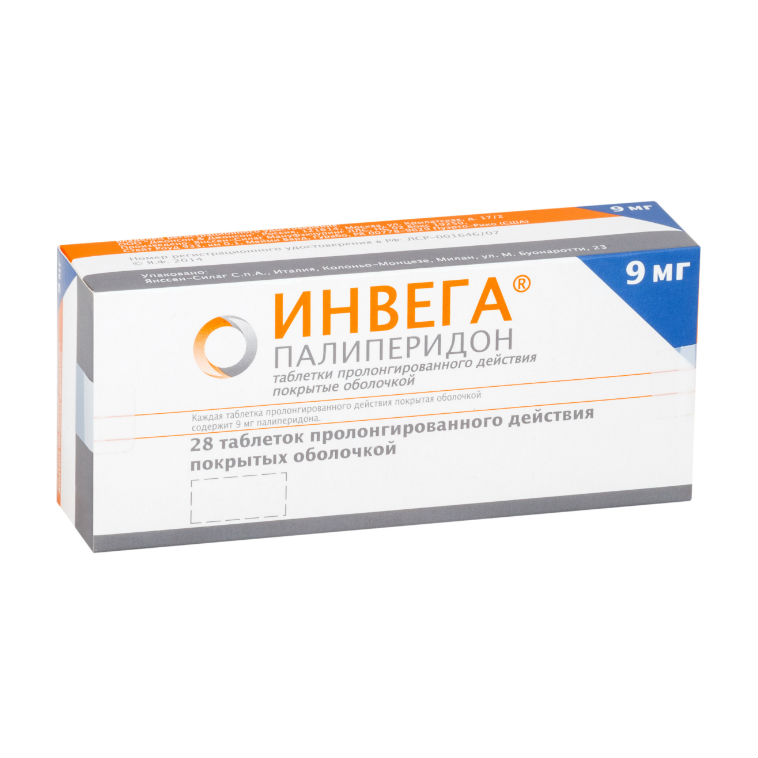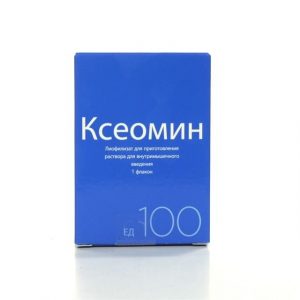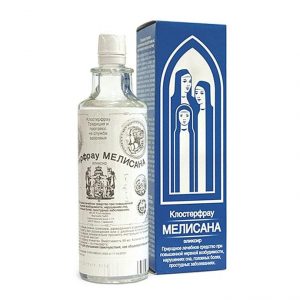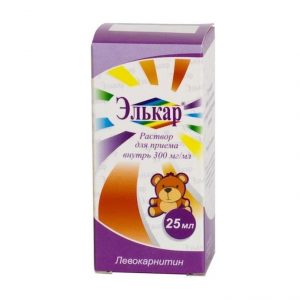Description
Release form
Extended-release tablets, film-coated
Packing
In a blister pack of 7 tablets. There are 4 blisters in the package.
Indications
schizophrenia, incl. in the exacerbation phase in adult
patients, prevention of exacerbations of schizophrenia in adults
treatment of schizophrenia in adolescents aged 12 to 17 years old
treatment of schizoaffective disorders: as monotherapy or as part of combination therapy with antidepressants and / or normotics in adult patients.
Contraindications
Contraindicated in patients with hypersensitivity to paliperidone, risperidone, as well as any auxiliary ingredient of the drug.
Caution: a history of seizures and medical conditions that lower the seizure threshold. Like other antipsychotics, paliperidone should be used with caution in patients with a history of seizures or other diseases that lower the threshold for seizure readiness.
Dysphagia and narrowing of the lumen of the gastrointestinal tract (the possibility of obstruction). Invega ® tablets do not deform and almost do not change their shape in the digestive tract, and therefore they should not be prescribed to patients with severe narrowing of the lumen of the gastrointestinal tract (pathological or iatrogenic), as well as patients who suffer from dysphagia or who have difficulty swallowing pills. There are rare reports of gastrointestinal obstruction symptoms associated with ingestion of non-deformable dosage forms with controlled release of the active substance. Paliperidone also belongs to such dosage forms, and therefore it can be prescribed only to those patients who can swallow tablets whole.
Elderly patients with dementia. The efficacy and safety of paliperidone was not evaluated in elderly patients with dementia. A meta-analysis of 17 placebo-controlled studies showed that elderly patients with dementia treated with atypical antipsychotic drugs such as risperidone, aripiprazole, olanzapine and quetiapine had a higher mortality rate compared with patients receiving placebo. Placebo-controlled studies, in which elderly patients with dementia participated, showed an increased frequency of cerebrovascular unwanted effects (strokes and transient ischemic attacks), including fatal in patients receiving some atypical antipsychotic drugs, including risperidone, aripiprazole and olanzapine, compared with patients who received placebo.
Parkinson’s disease and dementia with Levi bodies. Doctors should carefully consider the possible risks and potential benefits when prescribing antipsychotic drugs, including paliperidone, to patients suffering from Parkinson’s disease or dementia with Levy bodies, since such patients may have an increased risk of developing malignant antipsychotic syndrome (ANS) or increased sensitivity to antipsychotic drugs. Manifestations of this hypersensitivity include, in addition to extrapyramidal symptoms, confusion, dull reactions and postural hypotension with frequent falls.
Pregnancy and lactation
There is currently no data on the safety of paliperidone during pregnancy in women and its effect on fetal development. The drug should not be prescribed during pregnancy, except in cases of emergency from a clinical point of view. The effect of paliperidone on labor in women is not known.
The use of antipsychotic drugs in the third trimester of pregnancy was accompanied by reversible extrapyramidal symptoms in newborns.
Paliperidone is excreted in breast milk, therefore, the drug should not be prescribed during lactation.
Composition
1 sustained-release coated tablet contains: active substance: paliperidone 9 mg.
excipients: macrogol 200K, macrogol 7000K, sodium chloride, povidone (K29-32), hyethillose, stearic acid, butylhydroxytoluene, iron oxide red, iron oxide yellow, macrogol 3350, cellulose acetate (398-10), white dye (hypromellose titanium dioxide, lactose monohydrate, triacetin), carnauba wax.
Dosage and administration
Inside, tablets should be swallowed whole, washed down with liquid, they cannot be chewed, divided into parts or crushed.
Schizophrenia
Adults (over 18 years of age). The recommended dose in adults is 6 mg once a day, in the morning, regardless of food intake. A gradual increase in the initial dose is not required. In some patients, the therapeutic effect is caused by lower or higher doses within the recommended range of 3 12 mg once a day. There is a general tendency to enhance the effect when using large doses of the drug. If an increase in dose is necessary, it is recommended to increase the dose by 3 mg per day at intervals of more than 5 days.
Teenagers (12-17 years old). The recommended dose in adolescents is 3 mg once a day, in the morning, regardless of food intake. A gradual increase in the initial dose is not required. In some patients, the therapeutic effect is caused by higher doses within the recommended range of 6-12 mg once a day. A dose increase is possible only after clinical reevaluation, with a dose increase of 3 mg per day at intervals of more than 5 days.
Schizoaffective disorder
Adults (over 18 years of age). The recommended dose in adults is 6 mg once a day, in the morning. A gradual increase in the initial dose is not required. In some patients, lower or higher doses cause the therapeutic effect within the recommended range of 6 12 mg once daily. Increasing the dose, if necessary, should be carried out only after assessing the clinical condition of the patient. In case a dose increase is necessary, It is recommended to increase the dose by 3 mg / day at intervals of more than 4 days. Supportive therapy in patients with schizoaffective disorder has not been studied.
Patients with impaired liver function. In patients with a weak or moderate degree of impaired liver function, a dose reduction is not required. The use of Invega ® in patients with severely impaired liver function has not been studied.
Patients with impaired renal function. For patients with mild renal impairment (Cl creatinine? 50, but ® in patients with Cl creatinine
Elderly patients. For elderly patients with normal renal function (Cl creatinine? 80 ml / min), the same doses of the drug are recommended as for adult patients with normal renal function. However, in elderly patients, renal function may be reduced, and in this case, the dose of the drug should be selected in accordance with the renal function of a particular patient (see “Patients with impaired renal function”). Caution should be exercised when using the drug in elderly patients with dementia due to the increased risk of stroke. The effectiveness and safety of Invega ® in patients over 65 years of age with schizoaffective disorders has not been studied.
Children and adolescents. The efficacy and safety of Invega ® for the treatment of schizophrenia in children under 12 years of age has not been studied. The efficacy and safety of Invega ® for the treatment of schizoaffective disorders in patients under 18 years of age has not been studied.
Special patient groups
It is not recommended to change the dose of paliperidone depending on gender, age and whether the patient smokes or not.
Transfer of patients for treatment with other antipsychotic drugs
There is currently no systematically collected data on the transfer of patients treated with paliperidone to treatment with other antipsychotic drugs. The pharmacodynamics and pharmacokinetics of different antipsychotic drugs are not the same, and therefore doctors should carefully monitor the condition of patients when transferring them from one antipsychotic drug to another.
Side effects
Infections: often – upper respiratory tract infections, nasopharyngitis infrequently – urinary tract infections, acrodermatitis, bronchitis, inflammation of the subcutaneous fat, cystitis, ear infections, flu, onychomycosis, pneumonia, respiratory infections, sinusitis.
From the side of the immune system: infrequently – anaphylactic reaction, hypersensitivity.
From the hemopoietic and lymphatic system: infrequently – anemia, decreased hematocrit, neutropenia, a decrease in the number of leukocytes is rare – thrombocytopenia is very rare – agranulocytosis.
From the endocrine system: infrequently – hyperprolactinemia is very rare – inadequate secretion of ADH.
From the side of metabolism and nutrition: infrequently – increased CPK activity, anorexia, hyperglycemia rarely – diabetes mellitus, hypoglycemia, water intoxication very rarely – diabetic ketoacidosis.
Mental disorders: often insomnia (including primary and secondary insomnia), mania infrequently – nightmares, sleep disturbances, depression.
From the nervous system: very often – headache often – akathisia, dystonia, dysarthria, increased muscle tone, parkinsonism, sedation, drowsiness, tremors, salivation, infrequently – cerebrovascular disorders, postural dizziness, dyskinesia, cramps, fainting, impaired attention, hypesthesia, loss of consciousness, paresthesia, psychomotor hyperactivity, tardive dyskinesia, hypokinesia, opistotonus.
It is known that antipsychotic drugs, including paliperidone, can cause ZNS, which is characterized by hyperthermia, muscle rigidity, instability of the autonomic nervous system function, depression of consciousness, increased CPK activity, myoglobinuria, rhabdomyolysis, and acute renal failure.
From the side of the organs of vision: infrequently – conjunctivitis, dry eyes, photophobia, lacrimation with an unknown frequency – flabby iris syndrome (intraoperative).
On the part of the organ of hearing and labyrinth disorders: infrequently – pain in the ears, vertigo, ringing in the ears.
From the CCC side: infrequently – bradycardia, palpitations, AV block, conduction disturbance, ECG changes, increased QT interval, ischemia, flushing, increased blood pressure, low blood pressure rarely – atrial fibrillation is very rare – deep vein thrombosis, pulmonary embolism.
From the gastrointestinal tract: often – nausea, diarrhea, constipation, discomfort in the upper abdomen, dyspepsia, increased appetite infrequently – decreased appetite, lip inflammation, dysphagia, fecal incontinence, obstruction of the small intestine, flatulence, gastroenteritis, swelling of the tongue, toothache, dysgeusia is very rare – pancreatitis, intestinal obstruction.
From the liver and biliary tract: very rarely – jaundice.
From the respiratory system: infrequently – pain in the pharyngeal-laryngeal region, nasal congestion, cough, shortness of breath, hyperventilation of the lungs, wheezing rarely – sleep apnea.
From the side of musculoskeletal and connective tissue: often – myalgia, musculoskeletal pain infrequently – muscle cramps, back pain, arthralgia, stiffness in the joint, joint swelling, muscle weakness, neck pain.
From the skin and subcutaneous tissues: infrequently – rash, itching, acne, dry skin, eczema, erythema, seborrheic dermatitis, skin discoloration rarely – Quincke’s edema, alopecia.
From the kidneys and urinary tract: infrequently – dysuria, pollakiuria, urinary incontinence, urinary retention.
From the genitals and mammary gland: infrequently – decreased libido, anorgasmia, discharge from the nipples, erectile dysfunction, gynecomastia, menstrual changes, sexual dysfunction, vaginal discharge, violation of ejaculation, breast engorgement is very rare – priapism.
Effect on pregnancy, postpartum and perinatal conditions: very rarely – withdrawal syndrome in newborns.
Others: often – weight gain infrequently – weight loss, chills, facial swelling, impaired gait, swelling (including generalized, peripheral, mild), increased body temperature, fever, thirst very rarely – hypothermia.
Laboratory tests: infrequently – an increase in GGT activity, an increase in the activity of liver enzymes, an increase in the activity of transaminases, an increase in the concentration of cholesterol in the blood, an increase in the concentration of triglycerides in the blood.
Drug Interaction
Paliperidone is unlikely to enter into clinically relevant pharmacokinetic interaction with drugs metabolised by cytochrome P 450 isoenzymes. In vitro studies using human liver microsomes have shown that paliperidone does not significantly inhibit the biotransformation of drugs metabolised by cytochrome P 450 isoenzymes, including CYP1A4, CYP2A6, CYP2C8 / 9/10, CYP2D6, CYP2A4, CYPAE3, CYPAE3. Therefore, there is no reason to believe that paliperidone will inhibit the clinically relevant clearance of drugs that are metabolized by these enzymes. In addition, paliperidone, most likely does not induce enzymes. At therapeutic concentrations, paliperidone does not inhibit P-glycoprotein, and therefore is not capable of inhibiting the transport of other P-glycoprotein preparations to a clinically relevant extent. Given the fact that paliperidone acts predominantly on the CNS, it should be used with caution in combination with other drugs of central action and with ethanol. Paliperidone can neutralize the effects of levodopa and other dopamine agonists. Due to the ability of paliperidone to induce orthostatic hypotension, an additive effect may occur when the drug is administered concurrently with other orthostatic hypotension drugs.
Paliperidone is not a substrate for CYP1A2, CYP2A6, CYP2C9, CYP2C19 and CYP3A5 isoenzymes. This indicates a low probability of its interaction with the inhibitors or inducers of these enzymes. In vitro studies have shown minimal involvement of CYP2D6 and CYP3A4 isoenzymes in the metabolism of paliperidone, however, there is no evidence that these isoenzymes play a significant role in the metabolism of paliperidone in vitro or in vivo. Paliperidone, which is a cation at physiological pH values, is excreted predominantly in the unchanged form by the kidneys, with about half of the excretion accounting for filtration and about half for active secretion. The use of paliperidone at the same time as trimethoprim, which is known to inhibit the active renal transport of cationic drugs, did not affect the pharmacokinetics of paliperidone. The concomitant use of paliperidone and risperidone has not been the subject of scientific research. Paliperidone is an active metabolite of risperidone, and therefore, with the concomitant use of paliperidone and risperidone, it is possible to increase the plasma concentration of paliperidone.
Overdose
Symptoms are increased pharmacolchemical effects of the drug: drowsiness, sedation, tachycardia, arterial hypotension, QT lengthening and extrapyramidal symptoms. In case of acute overdose it is necessary to consider the possibility of toxic effects of several drugs.
Treatment: In evaluating the necessary therapy and the efficacy of overdose suppression, it should be borne in mind that Invega is a sustained release drug. There is no specific antidote for paliperidone. Conventional support measures must be implemented. A good airway and adequate oxygenation and ventilation should be maintained and maintained. Cardiovascular monitoring (ECG monitoring to detect possible arrhythmias) should be organized immediately. Arterial hypotension and collaptoid conditions are stopped in / in the introduction of fluid and / or sympathomimetics. In certain situations, gastric lavage (after intubation if the patient is unconscious), administration of activated charcoal and laxatives are indicated. When severe extrapyramidal symptoms occur, anticholinergic drugs should be administered. Patient monitoring and monitoring of basic physiological functions should be continued until the effects of overdose are completely eliminated.
Storage conditions
The drug should be stored at a temperature of 15 ° to 30 ° C.
Expiration
2 years.
Deystvuyuschee substances
Palyperydon
Pharmacy terms
pharmacy sfl17 presf1 p17pf6pf6pf6pf6pf6pf6pf6pf6pf6pf6pf6pf6pf6pf6pf6pf6pf6pf6pf6pf6pf5 Pharmacy terms
Prescription
dosage form and
Formulation




